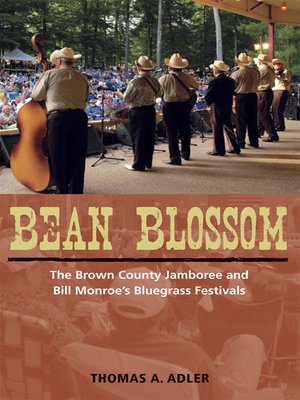Bean Blossom
ebook ∣ The Brown County Jamboree and Bill Monroe's Bluegrass Festivals · Music in American Life
By Thomas A. Adler

Sign up to save your library
With an OverDrive account, you can save your favorite libraries for at-a-glance information about availability. Find out more about OverDrive accounts.
Find this title in Libby, the library reading app by OverDrive.



Search for a digital library with this title
Title found at these libraries:
| Library Name | Distance |
|---|---|
| Loading... |
Bean Blossom, Indiana—near Brown County State Park and the artist-colony town of Nashville, Indiana—is home to the annual Bean Blossom Bluegrass Festival, founded in 1967 by Bill Monroe, the father of bluegrass. Widely recognized as the oldest continuously running bluegrass music festival in the world, this June festival's roots run back to late 1951, when Monroe purchased the Brown County Jamboree, a live weekly country music show presented between April and November each year. Over the years, Monroe's festival featured the top performers in bluegrass music, including Jimmy Martin, Lester Flatt, Earl Scruggs, the Goins Brothers, the Stanley Brothers, and many more. Thomas A. Adler's history of Bean Blossom traces the long and colorful life of the Brown County Jamboree and Bill Monroe's Bluegrass Festival. Adler discusses the development of bluegrass music, the many personalities involved in the bluegrass music scene, the interplay of local, regional, and national interests, and the meaning of this venue to the music's many performers—both professional and amateur—and its legions of fans. |
Cover
Title Page
Contents
Preface
Acknowledgments
Introduction: Rural Country Music Parks
1. Brown County History and Roots
2. Origins of the Brown County Jamboree, 1939–41
3. The Rund Family's Brown County Jamboree, 1941-51
4. Bill Monroe's Brown County Jamboree Park, 1952-57
5. Survivals, Revivals, and Arrivals, 1958-66
6. Building the Festivals, 1967-68
7. The Festival Becomes a Landmark, 1969-71
Illustrations follow page 122
8. The Festival's Golden Age, 1972-82
9. Festival People and Lore
10. Bill and James Monroe's Festival Park, 1983-97
11. Renaissance, Continuity, and Change, 1998 and After
Notes
Interviews
Bibliography
Index
|
"A welcome addition to the growing body of literature on the history of bluegrass. A clearly written and accessible book that combines history and folklore and offers an important case study of two twentieth-century musico-social phenomena: the rual country music park and the bluegrass festival."—American Music
"An important book in that it weaves together bluegrass music, the changing demographics of the music, the development of the music industry, and the evolving economic elements of staging events in the music park."—Journal of American Folklore
| Thomas A. Adler is a folklorist, banjoist, radio show host, and the former executive director of the International Bluegrass Music Museum. He lives in Lexington, Kentucky, and first attended Bean Blossom in 1968.
"Bean Blossom offers much-needed insights into one of the most important bluegrass music festivals. . . . Bluegrass aficionados and Bean Blossom regulars will certainly appreciate the care and attention that Adler has paid to the fan communities that have thrived in Brown County and across the globe."—Notes
"A welcome addition to the growing body of literature on the history of bluegrass. A clearly written and accessible book that combines history and folklore and offers an important case study of two twentieth-century musico-social phenomena: the rual country music park and the bluegrass festival."—American Music
"An important book in that it weaves together bluegrass music, the changing demographics of the music, the development of the music industry, and the evolving economic elements of staging events in the music park."—Journal of American Folklore
| Thomas A. Adler is a folklorist, banjoist, radio show host, and the former executive director of the International Bluegrass Music Museum. He lives in Lexington, Kentucky, and first attended Bean Blossom in 1968.







